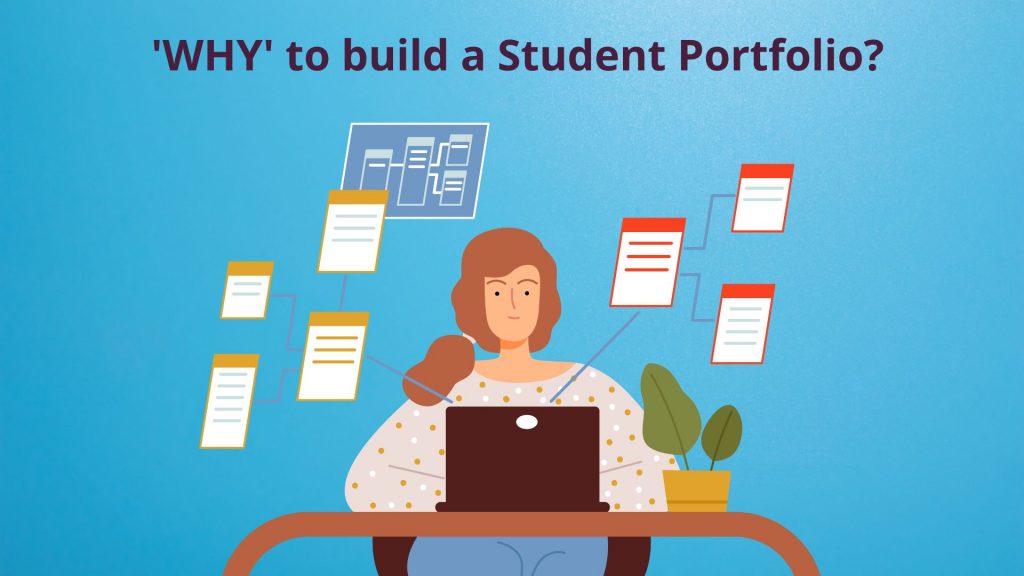Students take part in multiple activities throughout their school and college years. Some are more focused on academic projects, while some find their creative juices flowing in extra-curricular activities, competitions and hobby-based activities. In all this, students learn by doing, improve from failures, experience success, and share their ideas and thoughts with peers, teachers and mentors.
Documenting the learning process in a student’s portfolio is important since the process behind the learning often gets neglected otherwise. So what is a portfolio for students? And how students can create one for themselves. Building a student portfolio is about how students want to organize and present their projects. When students build their e-portfolios, it gives them a place to assess their work, think about it, and draw connections among various related topics and activities.
Do students need a portfolio?
Yes! With the help of their digital portfolios, students can highlight their abilities and educational experiences.
In a student’s digital portfolio, achievements from various Grades are documented. It provides a succinct summary of student life and showcases students’ best work, which they can share with whoever they choose. A digital portfolio is a place for students to explore, record and reflect on their academic journey.
How do digital portfolios help students? Students in charge of their portfolios learn how to record, curate, and decide what to include and exclude in the portfolio based on their interests. Students develop critical thinking skills and self-confidence while showcasing their best work by compiling portfolios and presenting them to their teachers and classmates. A student portfolio is crucial while applying for higher studies, internships and jobs as it shows evidence of learning.
Student portfolio for primary/elementary students
Teachers and parents can help to create an online digital portfolio for students. Finding an easy-to-use tool to build a portfolio is of utmost importance. Students from primary grades participate in many activities and get hands-on experience, and the outcomes of these activities can be included in their portfolios. Teachers and parents can also contribute to the portfolio by writing their observations on the child’s progress. It may seem a little early to start with a portfolio for elementary students; however, it goes a long way. Students learn how to organize their work and present it to their friends, parents and teachers.
Student portfolio for secondary students
Students can exercise their creativity while doing their assignments and projects. Students can include multiple types of projects in their portfolios. Some examples include Science fair project – Making a solar oven, A coding application – A mobile app, A robotics challenge – Designing a robotic hand, An art and design work – Design roller coasters. There are multiple sites to make an e-portfolio. Here’s a complete guide to using a digital portfolio.
Students go through the entire process of creation and curation of multimedia elements. Student portfolios demonstrate their understanding and competencies through their work. Portfolios help students develop organizational skills and have a secure digital place where students get to store these artifacts of their learning. Students can curate their learning stories and reflect on how far they’ve progressed from the beginning of the year with a collection of files and projects.
Student portfolio for scholarship
Students should start building their portfolios in high school and keep doing so as they progress through college and seek scholarships. Why should the portfolio begin in high school? Career counsellors emphasize having a personal portfolio for students. Applying for scholarships will be easier and less stressful if you have these materials organized in a portfolio, which is a central repository for all your scholarship-related materials.
- Academic achievements
- Extracurricular activities
- Volunteering activities
- Honours and Awards
- Leadership positions
Students’ scholarship application portfolio is key to becoming successful scholarship applicants. Even though it might initially seem like a lot of work, it is ultimately quite worthwhile.
Student portfolio for college admission?
With a digital portfolio, students are better equipped when applying for college admissions and internships. They can showcase their best work done throughout their school/college years. They can capture, reflect on and showcase project-based learning through multimedia in an organised manner.
An e-portfolio helps students to go beyond academic grades, dig deeper into their interests and skills and present a comprehensive overview of their learning journey. A digital portfolio can be considered a new resume. Students can distinguish themselves from the competition and display their uniqueness using a portfolio to demonstrate their abilities and accomplishments.
Digital portfolios for Graduate Students
Whether students create their e- portfolio independently or as part of a course, program, or internship requirement, it is recommended that graduate students should always consider its purpose and intended audience. When students reflect on learning experiences, they can decide what to include in their portfolios based on their interests.
Who all can be interested in student’s digital portfolio:
- Mentors
- Peers
- Friends and Family
- Potential Employers
Students own their learning and learning outcomes by creating digital portfolios. This student-driven learning goes a long way and offers scope for student-centric pedagogy. Students can use digital portfolios to track their progress over time, and teachers can assess pupils’ progress.
Student portfolio to develop 21st-century skills
When organising artefacts for an e-portfolio, one must think imaginatively about how to arrange their materials and choose the most effective way to convey their learnings. All of this helps to exercise and gradually enhance the abilities necessary for the workforce. Effective communicating, planning, arranging, summarising, reflecting, and developing presentations for an audience are all examples of skills.
One might gain insight from the opinions or responses of others by getting feedback on the work uploaded in the e-portfolio. Another skill that can be gained is taking this criticism constructively.
Student portfolio for the internship?
A student’s digital portfolio can be compared to a modern, dynamic CV. Students can highlight their projects, important lessons learned, and skills through their portfolios. In a more detailed way than a résumé, students can organise, reflect on, and exhibit project-based learning through multimedia.
Students can distinguish themselves from the competition and display their uniqueness by using a portfolio to demonstrate their abilities and accomplishments. Students can create interactive CVs and student portfolios on Mysphere. Watch this video to learn more about how Mysphere can assist students in developing their CVs and portfolios.
How does a portfolio help you get a job?
A student’s learning journey and development throughout time are documented in a portfolio. An e-portfolio has its own weight when applying for college or university admissions at a foreign institution. Learn more about the article on the importance of student portfolio to students.
Students get to analyse and identify their strengths and weaknesses, which also gives an overview of their growth as a learner. One can also refer to it as a growth portfolio for students. A student portfolio is a powerful tool as students turn into candidates applying for higher education and job applications.
Potential employers find great value if candidates have an impressive e-portfolio that showcases their accomplishments and self-growth over time.
What should students include in their digital portfolio?
We suggest a digital portfolio containing pages about academic development, professional development, and teaching (when applicable) with yearly reflections on skills and knowledge gained, goals achieved, and plans for reaching future milestones. Students can start with their e-portfolio with one artifact initially and continue building afterwards by adding multiple projects across various subject areas and interests.
Students can provide an explanation for any uploaded evidence, demonstrate professionalism and growth, and reflect on what they have learned and why it’s of value.
Some things to include:
- Self-introduction or “about me” page
- Well thought out research statement
- Samples of your best writing
- Examples of projects supported with multimedia – images/videos
- Recorded presentations
Build your student portfolio now and let opportunities find you.

